Georgette Heyer’s third novel was unique. It is her shortest book, she wrote it in three weeks and it was her only book written under a pseudonym. The Transformation of Philip Jettan by “Stella Martin” was published in April 1923 and it’s possible that only her closest friends and family knew it was really a Georgette Heyer novel. We don’t know exactly why she chose to hide her identity for this, her third book, though it may have had something to do with her being under contract to Hutchinson at the time. The previous year they had published The Great Roxhythe and would publish Heyer’s first contemporary novel, Instead of the Thorn, in November 1923. For Heyer to publish another novel with a different publisher would undoubtedly have been frowned upon and may even have been a breach of contract – a powerful reason to publish the new book under another name.
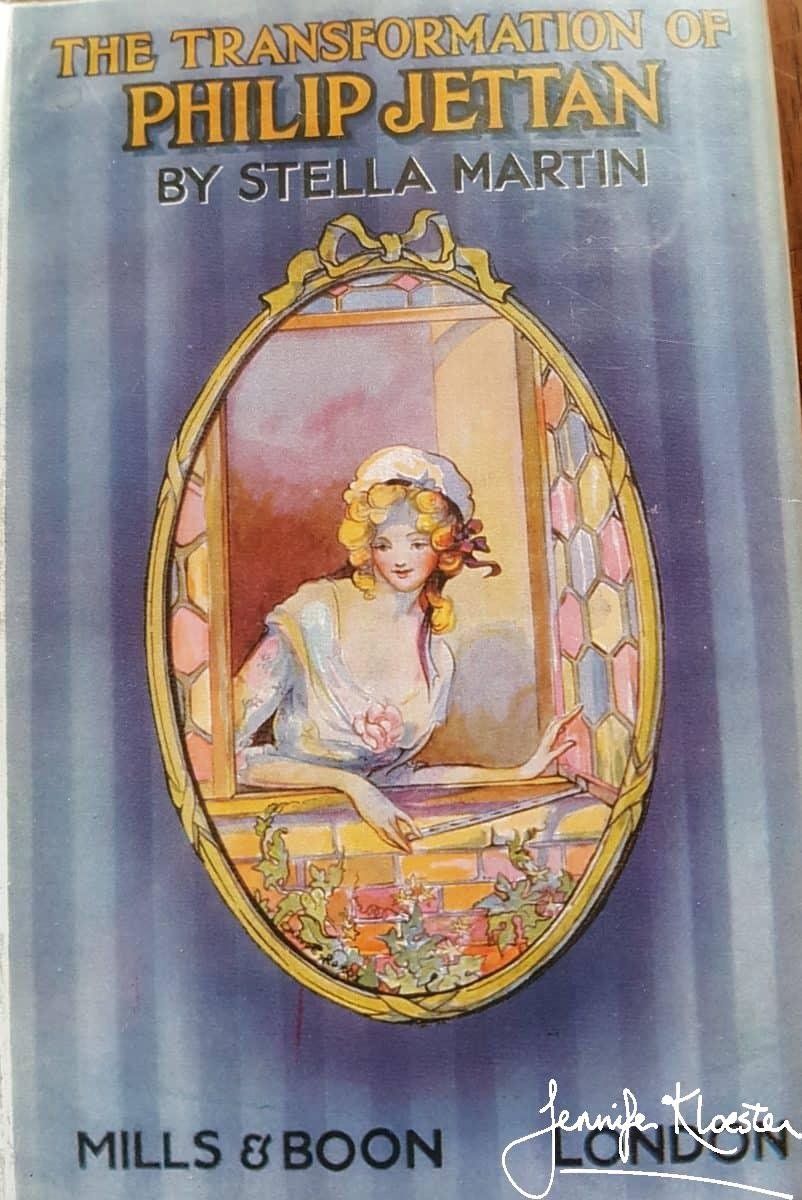
Much misunderstood: Mills & Boon
The Transformation of Philip Jettan was published by Mills & Boon which, in those days, was still a large general publisher. Years before the company instigated its famous romance brand, Mills & Boon published all kinds of books, including travel guides, cookery books, Shakespeare’s plays, novels, biographies, memoirs, sporting guides, self-help books, financial texts and a variety of reference books about history, psychology, religion and the natural world.
Founders Gerald Mills and Charles Boon were committed to general publishing, including fiction of a ‘popular’ and a ‘quality’ vein. The latter included the great and the near-great… P.G. Wodehouse, Hugh Walpole, Victor Bridges, Jack London, E.F. Benson, Georgette Heyer, Denise Robins, and Constance Holme were all published by the firm.
Joseph McAleer, Passion’s Fortunes: the Story of Mills & Boon, p.3.
It wasn’t until 1930 that Mills & Boon began to specialise in romance fiction but the decision marked a watershed in the company’s history. Already a successful publisher, they would eventually reach the heights of publishing success and their name would become so instantly recognisable that in 1997 it would be added to the Oxford English Dictionary with the definition: “romantic, story-book”. The firm built its success on the fact that readers love romance. Today, romance fiction accounts for almost fifty per cent of all novels sold and, while there are still those who will deride genre fiction, Mills & Boon knew better:
You see, we never despised our product. I think this is highly important. A lot of people who publish romantic novels call them ‘funny little book’s that make a bit of profit. We never did that. We never said this was the greatest form of literature, but we did say that of this form of literature, we were going to publish the best.
John Boon, Mills & Boon Chairman, son of co-founder, Charles Boon,
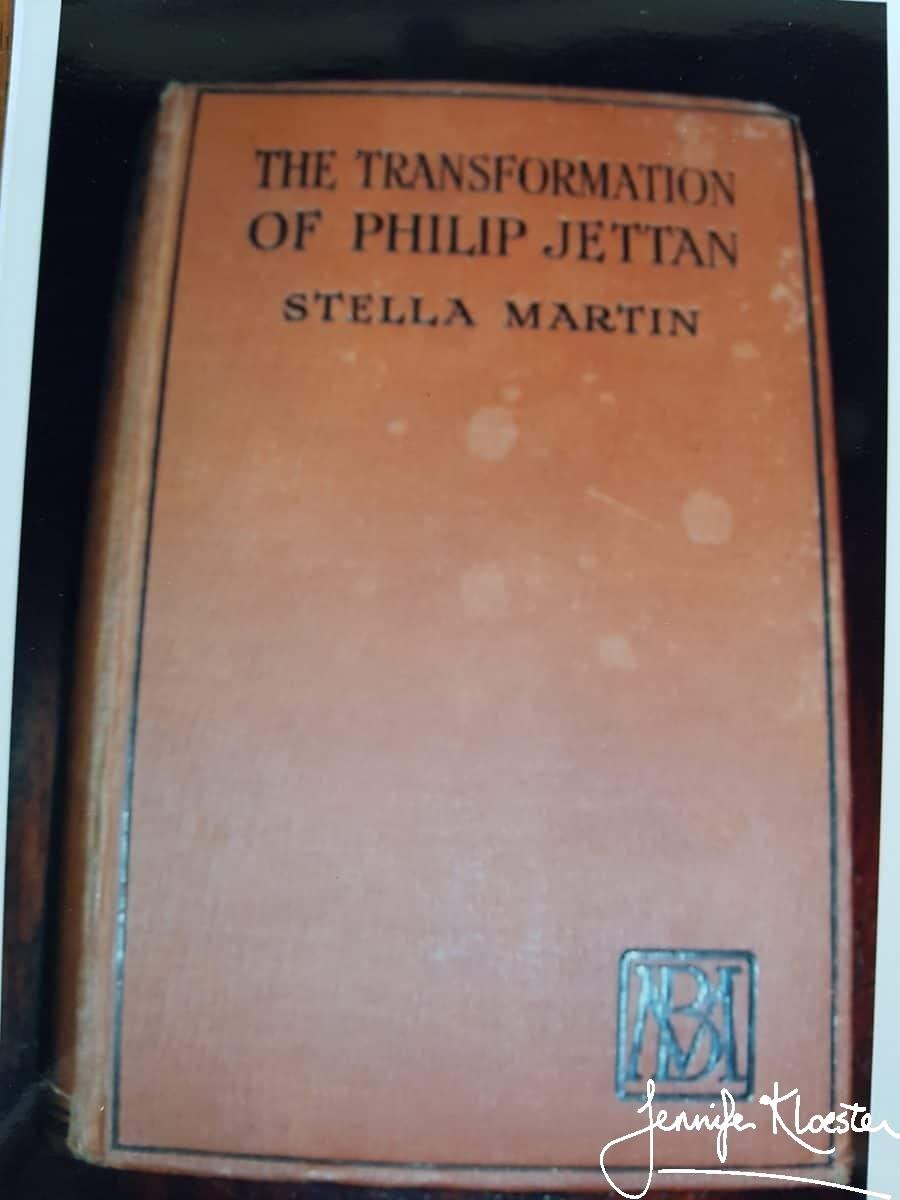
Georgette Heyer’s first edition copy with the Mills & Boon insignia on the cover. 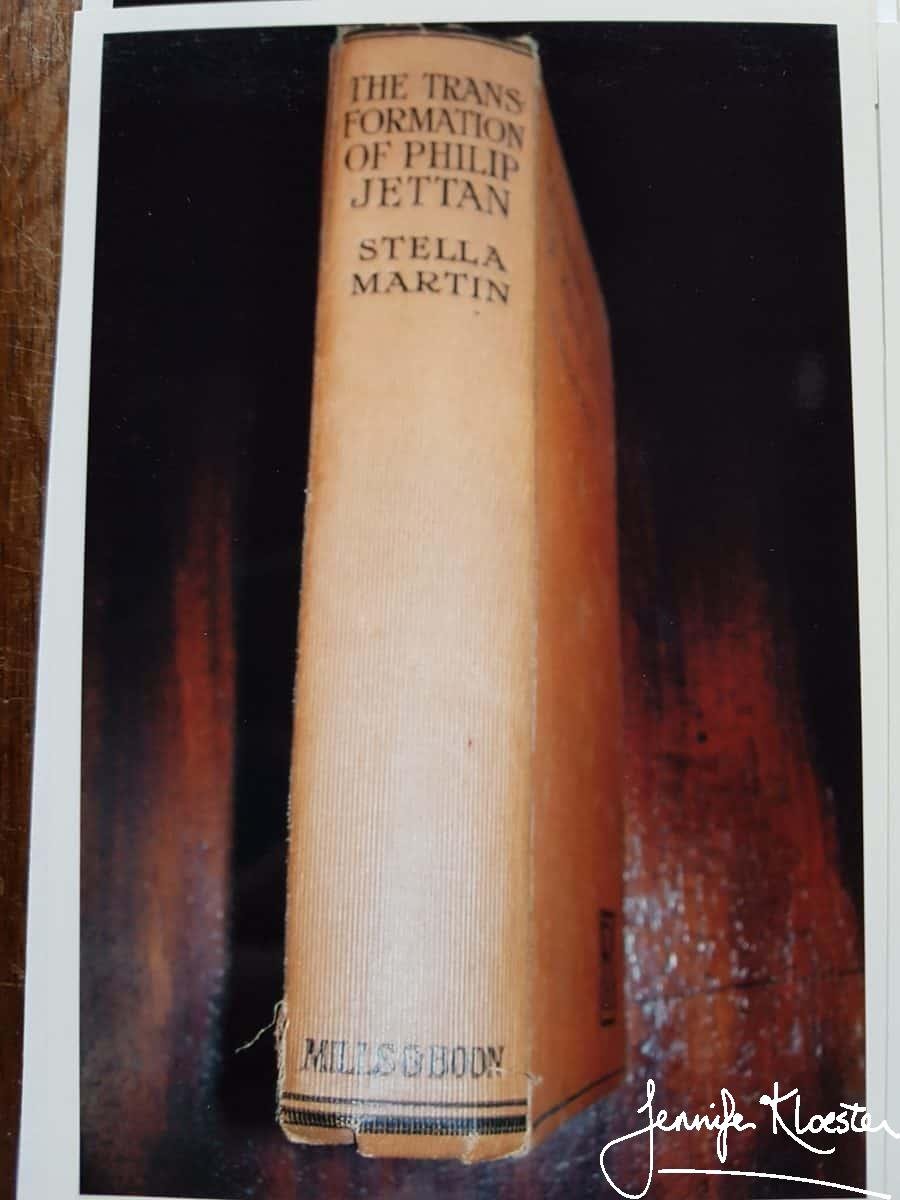
The spine with the Georgette’s pseudonym in bold type. 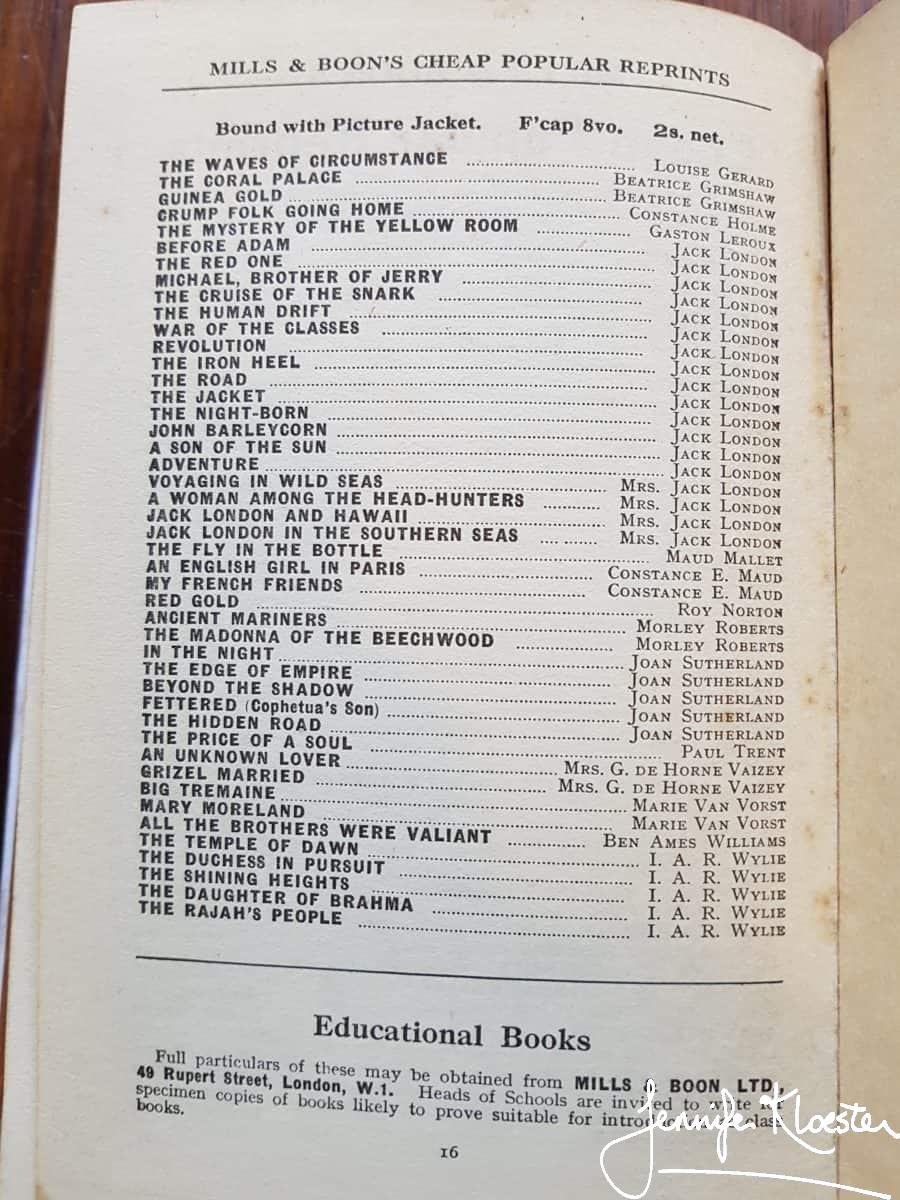
Some well-known names appeared in the advertising material at the back of the novel.
This was her own copy which Georgette probably gave to her father.
In 1923, The Transformation of Philip Jettan was one of more than one hundred novels listed in the Mills & Boon catalogue. It would be interesting to know if the firm’s founders ever knew that their one-off author ‘Stella Martin’ was actually Georgette Heyer; it would be even more interesting to know for certain why she chose to use a pseudonym. So far the only other known composition which Georgette published as ‘Stella Martin’ was her 1925 short story entitled ‘The Old Maid’, a copy of which may once again be read in Acting on Impulse, a collection of Heyer short stories published in 2019.
Written in three weeks
Though this was her second published novel set in the eighteenth-century, The Transformation of Philip Jettan was actually Georgette Heyer’s third story set in that era. Her second eighteenth-century novel was really These Old Shades which she’d begun writing in 1922, at the age of nineteen. That story was intended as a “sequel” to The Black Moth (more on These Old Shades on 5 June 2020) and by January 1923 it was nearly finished. At some point during the writing of that book, Georgette must have been struck by the idea for The Transformation of Philip Jettan for she wrote the new novel in just three weeks. A light-hearted romantic story, its countrified hero, Philip Jettan, is in love with the fair Cleone. She loves him, but wishes he were more fashionable. Angered by his beloved’s rejection of him as he is, Philip travels first to London and then to Paris in order to effect his ‘transformation’. As always in a Georgette Heyer novel, there is more to the story than meets the eye.
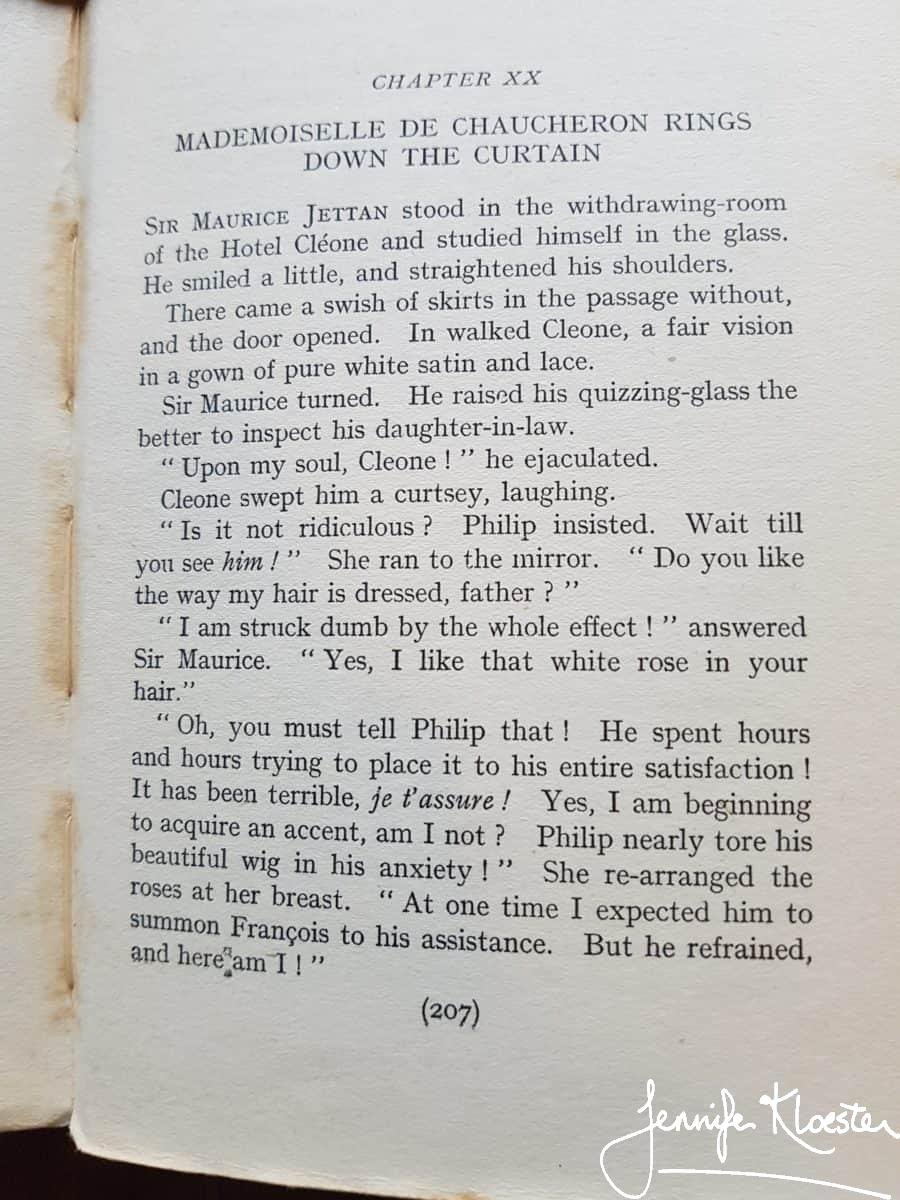
The original final chapter which was deleted from the 1930 Heinemann reprint. 
A reprint of the complete novel, with the missingfinal chapter, now available in the USA due to the 95-year copyright rule.
Restoration Comedy
Perhaps one of the reasons that Georgette’s eighteenth-century novels have remained so popular is their energy. Georgette’s father had brought her up on a rich literary diet and among her favourite things to read were the Restoration comedies of playwrights such as Sheridan and Congreve. From them she learned much about comedies of manners, wit and wordplay, and also became familiar with the rake, the fop and the cross-dressing heroine – hugely popular figures in the seventeenth century – and all of whom Georgette would use many times in her own novels. There is an unmistakeable spirit of Restoration Comedy in The Transformation of Philip Jettan with its aristocratic affectations, its gentle ridiculing of the marriage mart, and its way of poking fun at Philip as both fop and rake. These As Diane Maybank explains in her excellent article,
‘The comedy of manners was Restoration comedy’s most popular subgenre. Although they ultimately uphold the status quo, these plays scrutinise and ridicule upper-class society’s manners and rules of behaviour, providing an up-to-the-minute commentary on class, desire and the marriage market.
Diane Maybank, ‘An Introduction to Restoration Comedy’, British Library, 21 June 2018
Her father’s influence?
Of all of Georgette Heyer’s novels, The Transformation of Philip Jettan is the only one to feature poetry. Once in Paris, Philip enthusiastically embraces his transformation and develops a passion for fashion, fencing and furbelows. To the mock horror of his aristocratic new friends, he also takes to writing poetry – in both English and French – and worse, insists on reading his poems aloud to them. It is here that one suspects that Georgette’s father’s penchant for poetry makes itself felt. George Heyer loved writing poetry and among a collection of twenty of his published and unpublished verses are a ballade, a sonnet and a rondeau. In The Transformation of Philip Jettan a rondeau written in French features midway through the book when Philip arrives ready to entertain his friends with a recitation. George Heyer was himself a fluent French speaker and although Georgette also spoke French, if he did not write the poems for her novel in their entirety, her father would undoubtedly have had a hand in their creation:
Into the room came, Philip, a vision in shades of yellow. He carried a rolled sheet of parchment tied with an amber ribbon. He walked with a spring, and his eyes sparkled with pure merriment. He waved the parchment roll triumphantly. Saint-Dantin went forward to greet him. "But of a lateness, Philippe," he cried, holding out his hands. "A thousand pardons, Louis! I was consumed of a rondeau until an hour ago." "A rondeau?" said De Vangrisse. "This morning it was a ballade!" "This morning? Bah! That was a year ago. Since then it has been a sonnet!" ... "Devil take your rondeau," cied the Vicomte... "A l'instant!" Philip untied the ribbon about his rondeau and spread out the parchment. "I insist that you shall listen to the product of my brain!" ... "Cette petite perle qui tremblotte Au bout de ton oreille, et qui chuchotte Je ne sais quoi de tendre et de malin ...
And so Philip continues for three verses until, as he pause for the climax, he is rudely interrupted by one of his friends, with a witty alternative ending at which point Philip throws the parchment at his head. There are some sparkling moments in Heyer’s third published novel, but among her many novels it is a more a tasty hors-d’oeuvre than the feasts which were to come.
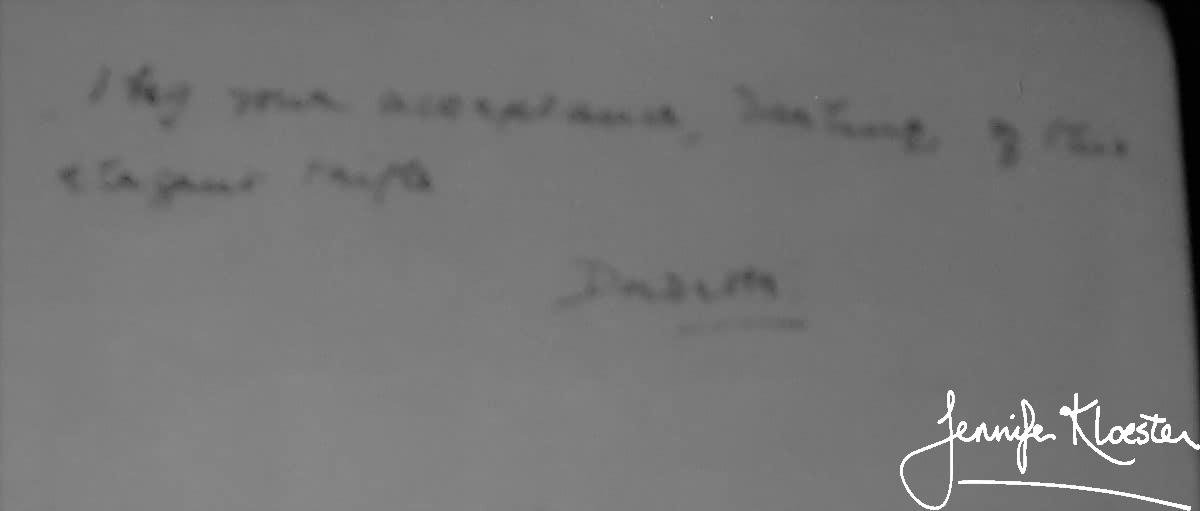
The first edition in Georgette’s library most probably signed to her father using her family nickname, “Dordette”.





2 thoughts on “The Transformation of Philip Jettan”
Ms Kloester, Powder and Patch has always been on my first Heyer reread list. This is entirely because I find Phillip delightful. He proves that not only can you take Phillip out of the country you can also take the country out of Phillip. I’m not a fan of Cleone. I’m glad Georgette didn’t really use her as a model for many more heroines? Although secondary characters (foils) like Juliana Marling remind me of Cleone.
I always read the deleted final chapter as the closing chapter. I like to think of Cleone as getting to know Phillips French friends and maybe improve her at least they will make her see Phillip in a new light. https://www.shelaghlewins.com/other_stuff/cleone.php
What a lovely comment on Philip and Powder and Patch. Thank you for writing. I’ve always felt a bit sorry for Cleone – she is so much a product of her time. She loves Philip from the very beginning but wants him to fit society’s view of what a man should be. I agree with you about the final chapter – I love reading about them in Paris together and Philip’s poetry always makes me laugh! I do hope you enjoy the rest of the posts. There will be one very Friday until September next year when we celebrate the 100th anniversary of The Black Moth. An amazing achievement! I do hope you’ve joined us in the International Heyer Society. Thank you again for writing.